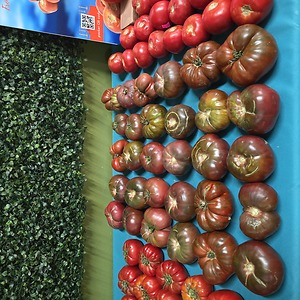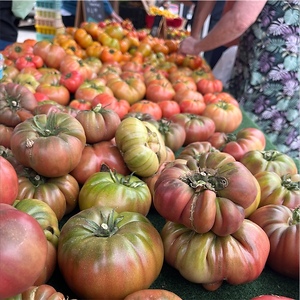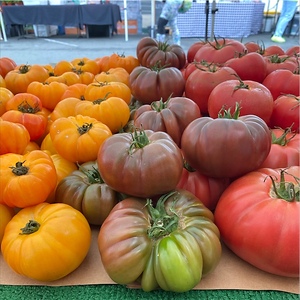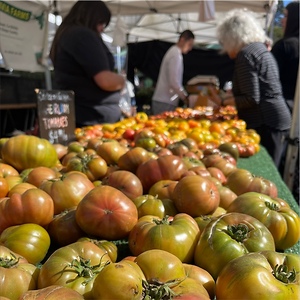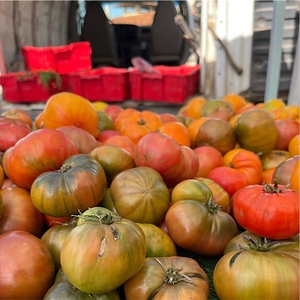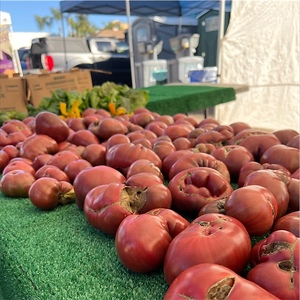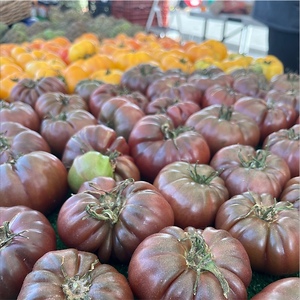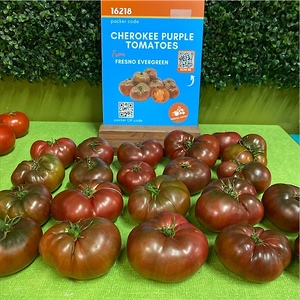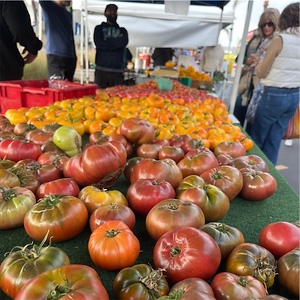


Cherokee Purple Heirloom Tomatoes
Estimated Inventory, 10 lbs : 0
Description/Taste
Cherokee Purple tomatoes are a medium to large varietal, averaging 12 to 13 centimeters in diameter and 226 to 453 grams in weight, and have a round, oblate, flattened shape. The variety is notably ribbed and occasionally features irregular creases, lumps, and bulges, depending on the growing environment. The tomato’s skin is thick, smooth, and taut, showcasing variegated dark red, purple, and brown hues. There are also patches of dark green on the tomato’s shoulders around the leafy stem cap, and tiny yellow dots are scattered across the surface. Underneath the skin, the flesh is dense and meaty, encasing central chambers filled with seeds. Cherokee Purple tomatoes have a semi-firm, crisp, aqueous, tender, and succulent consistency. The central chambers are filled with a gelatinous liquid, and the small, round, and flat seeds are suspended in the liquid. Cherokee Purple tomatoes release an earthy, aromatic, and fruity scent when sliced and are edible raw once ripe. The variety has a sweet, acidic, savory, refreshing, tangy, and earthy, smoky flavor.
Seasons/Availability
Cherokee Purple tomatoes are available in the mid-summer through late fall, typically until the first frost.
Current Facts
Cherokee Purple tomatoes, botanically classified as Solanum lycopersicum, are an American heirloom variety belonging to the Solanaceae or nightshade family. The story of Cherokee Purple tomatoes is centered around history, color, and flavor. The variety is rumored to date back before the 1890s and later became one of the most popular home garden heirloom tomatoes in the late 20th and early 21st centuries through the efforts of American seed saver programs and heirloom tomato advocates. Cherokee Purple tomatoes are a pigmented, open-pollinated heirloom, meaning the seeds produced each season are identical to those of the parent plant. This characteristic has allowed the variety’s seeds to be saved between generations. Gardeners also value Cherokee Purple tomatoes for their indeterminate nature, continuing to grow and produce fruits throughout the season. Cherokee Purple tomatoes are annually grown in home gardens as a culinary variety. The vining plants reach up to 1.5 meters in height and thrive on trellises and stakes for additional support while producing large fruits. Cherokee Purple tomatoes also mature in 70 to 85 days and exhibit natural disease resistance and tolerance to heat and humidity. Since their release to growers, Cherokee Purple tomatoes have remained a specialty heirloom. The tomatoes are not grown commercially on a broad scale as they cannot be transported long distances. Cherokee Purple tomatoes are primarily localized to home gardens and farmer’s markets. The large, fleshy tomatoes are known for their sweet and savory flavor and are a versatile variety utilized in a wide array of fresh and cooked culinary preparations.
Nutritional Value
Cherokee Purple tomatoes are a source of vitamin C, a nutrient that helps strengthen the immune system. The variety may also contain vitamin A, which helps promote eyesight and healthy teeth and skin. Tomatoes, in general, provide potassium and calcium, which are important for heart, kidney, and muscle health, and contain other nutrients, including vitamin K, folate, fiber, and B vitamins. Pigmented tomatoes, including Cherokee Purple, are notably a source of lycopene, a carotenoid found in the flesh and skin with antioxidant properties to reduce inflammation and protect the cells against the damage caused by free radicals.
Applications
Cherokee Purple tomatoes have a sweet, acidic, and savory taste suited for fresh and cooked preparations. The variety is recommended to be vine-ripened for the best flavor, and the skin, flesh, and seeds are edible. Cherokee Purple tomatoes are often promoted as a fresh-eating variety and are sliced and eaten as a stand-alone snack, sometimes sprinkled with salt. The variety can also be layered into sandwiches, used in caprese, or diced into salads. Cherokee Purple tomatoes add unusual coloring to salsas and sauces and are versatile in everyday culinary preparations. They also add a balanced flavor to soups and stews. Their dense, meaty flesh adds texture to pasta, or they can be sliced, breaded, and fried. Cherokee Purple tomatoes are halved, stuffed with rice and cheese, and baked as a savory meal, used as a pizza topping, or added to onion tarts. They can also be incorporated into recipes calling for beefsteak tomatoes. Cherokee Purple tomatoes pair well with herbs such as basil, cilantro, oregano, and parsley, aromatics including garlic, shallots, and onions, celery, asparagus, carrots, and legumes. Whole, unwashed Cherokee Purple tomatoes will keep for 2 to 3 days after harvest. The stems should be removed, and the tomatoes should be stored upside down at room temperature. Cherokee Purple tomatoes can also be canned or frozen for extended use.
Ethnic/Cultural Info
Cherokee Purple tomatoes were named by American tomato grower and heirloom collector Craig LeHoullier. The variety was being grown in LeHoullier’s home garden in 1990, and LeHoullier chose the varietal name from the tomato’s distinct coloring and rumored Cherokee heritage. Craig LeHoullier was a chemist based in Raleigh, North Carolina, and always had a passion for gardening. He began planting tomatoes in his home garden in the 1980s and dedicated his available time to growing heirloom varieties. It is said LeHoullier, at one point, had one of the largest personal tomato collections in the United States and started joining seed swaps through the Seed Savers Exchange in 1986. It is important to note that when LeHoullier promoted Cherokee Purple tomatoes, black tomatoes were uncommon in the United States. Seed companies were unsure how consumers would react to seeing dark purple, variegated tomatoes, and Cherokee Purple tomatoes, which were occasionally referred to as having a color reminiscent of a dark bruise in their early stages. Despite these fears, Cherokee Purple tomatoes became a favored heirloom variety for their quality flavor, and as other types of black tomatoes were introduced into American markets in the late 1990s and early 2000s, purple-hued tomatoes continued to rise in popularity. In 1995 and 1997, Craig LeHoullier also found two natural mutations in his Cherokee Purple tomato plants, eventually naming them Cherokee Chocolate and Cherokee Green tomatoes. All three Cherokee varieties are promoted as specialty cultivars for home garden cultivation and have also been used for breeding improved, modern varieties.
Geography/History
Cherokee Purple tomatoes were discovered in the United States and are an heirloom cultivar with several theories behind their arrival into local markets. Much of the early history of Cherokee Purple tomatoes is unknown. Tomatoes are not indigenous to North America and were introduced over time through migrating populations in Central and South America and from plantings established by European settlers. Historians and experts hypothesize that Cherokee Purple tomatoes may have arisen as a natural mutation of red tomatoes being grown by the Cherokee Nation in Tennessee. Other theories point to the variety being a descendant of black tomato cultivars introduced from the Crimean region of the former Soviet Union or from the Philippines. While all these theories are simply speculation, what is known is that seeds for the first documented Cherokee Purple tomatoes were recorded in the late 20th century. In 1990, a man named John Green from Sevierville, Tennessee, sent seeds of a tomato variety he collected from his neighbor to well-known heirloom tomato breeder Craig LeHoullier. Mr. Green included a handwritten note stating that the seeds were received by a woman who had acquired them from her neighbors, who had allegedly been growing the variety in their garden for over one hundred years. It was also said that these seeds were originally given to the family by members of the Cherokee Nation in Tennessee. Craig LeHoullier planted the seeds in his garden in 1990 and began offering the variety on seed-saver exchange platforms in 1991 under the name Cherokee Purple. LeHoullier also sent the seeds to Jeff McCormick of Southern Exposure Seed Exchange and Rob Johnston of Johnny’s Selected Seeds for widespread distribution. Cherokee Purple tomatoes were listed in the Southern Exposure Seed Exchange’s 1993 catalog and were described in the booklet as a variety for “adventurous gardeners.” Since their release in the 1990s, Cherokee Purple tomatoes have become a choice variety for home gardens throughout the United States. The variety is also grown on a small scale for sale through local farmer’s markets.
Recipe Ideas
Recipes that include Cherokee Purple Heirloom Tomatoes. One
Podcast



